Extensive Nuclear Missile Deployment Area Discovered in Central China
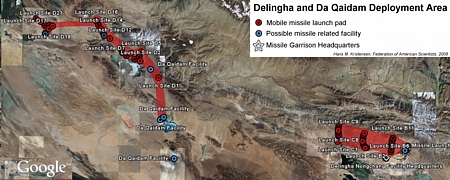 |
| More than 50 launch pads for nuclear ballistic missiles have been identified scattered across a 2,000 square kilometer (772 square miles) area of central China, according to analysis of satellite images. Click image for full size. Also download GoogleEarth KMZ file. |
.
By Hans M. Kristensen
Analysis of new commercial satellite photos has identified an extensive deployment area with nearly 60 launch pads for medium-range nuclear ballistic missiles in Central China near Delingha and Da Qaidam.
The region has long been rumored to house nuclear missiles and I have previously described some of the facilities in a report and a blog. But the new analysis reveals a significantly larger deployment area than previously known, different types of launch pads, command and control facilities, and missile deployment equipment at a large facility in downtown Delingha.
The U.S. government often highlights China’s deployment of new mobile missiles as a concern but keeps the details secret, so the discovery of the deployment area provides the first opportunity for the public to better understand how China operates its mobile ballistic missiles.
Description of Deployment Area
The deployment area is located in the northern parts of the Qinghai province and consists of two areas west of Delingha and Da Qaidam. In total, 58 launch pads have been identified scattered over an area stretching roughly 275 kilometers (170 miles) along highway G315 leading from Delingha through Da Qaidam to Mahai (see banner image for details). Nearly all launch pads detected so far are located on the north side of the road. Combined, the deployment area covers approximately 772 square miles (2,000 square kilometers).
|
Figure 1: |
 |
|
36 launch pads and the 812 Brigade Base have been identified in and around Delingha. Click on image to see full size |
The Delingha (德令哈) deployment area stretches approximately 52 kilometers (32 miles), covering 1,000 square kilometers (386 square miles) west of the city of Delingha (see Figure 1). A total of 36 launch pads have been identified along three side roads extending north from the main road. The three strings of launch pads are separated by 16-20 kilometers (10-12 miles). This area appears to be very active with missile operations detected in 2005 and 2007, and several facilities in downtown Delingha associated with missile operations are identified below.
|
Figure 2: |
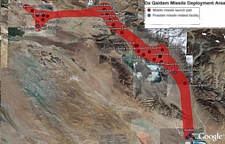 |
|
22 launch pads have been identified northwest of Da Qaidam. Click on image for full size |
The Da Qaidam deployment area stretches for more than 100 kilometers (62 miles) west of the city of Da Qaidam Zhen all the way past Mahai, covering an area of 1,100 square kilometers (424 square miles). A total of 22 launch pads have been identified alongside and to the north of the main road (see Figure 2). This deployment area shows clear wheel tracks at several of the pads, including what might be construction of new pads or maintenance of existing ones. Unlike in Delingha, no missile related facilities have yet been identified in or around Da Qaidam itself, except for what appears to be a surface-to-air missile (SAM) site in the city itself and what might be a command and control facility further south near Xiao Qaidam.
There are probably more launch pads and facilities between Delingha and Mahai, but satellite photos of a couple of areas are not yet available on Google Earth.
From these launch pads DF-21 missiles would be within range of southern Russia and northern India (including New Delhi), but not Japan, Taiwan or Guam.
|
Figure 3: |
 |
|
Four basic launch pad designs have been detected ranging is size from 15-70 meters. |
Launch Pad Designs
The 58 launch pads include four basic designs: a 70-meter full circle; a 40-meter T-shape, a 15-45 meter rectangular, and a 30-meter pull-out (see Figure 3). The 15-meter rectangular is by far the most common design. There are two full circle pads and four T-shape pads.
The large circular pads are probably older designs for the liquid-fuel DF-3 and DF-4, which require a large number of fuel trucks on the pad until shortly before launch. The liquid-fuel missiles are now being phased out and replaced with the solid-fuel DF-21 and DF-31, which require fewer support vehicles. The DF-31 has not been reported in the Delingha and Da Qaidam areas, but its smaller predecessor the DF-21 has deployed there for several years and can be launched from the small 15-meter pads. Two of the pads in Figure 3 show what are estimated to be DF-21 launchers, a 2006 deployment previously described here.
The pads could potentially also be used by short-range missiles such as the DF-11 and DF-15. But the DOD has repeatedly stated in its annual reports on China’s military that “all of [China’s] SRBM units are deployed to locations near Taiwan.”
Several of the smaller 15-meter launch pads appear to have a small infrastructure consisting of a tiny building located approximately 150 meters from the pad. A few also have larger structures nearby.
Command and Control Facilities
The satellite photos also show what appear to be buried command and control (C2) facilities at each deployment area. They are hard to find because they blend in with the other pads, but a closer look reveals that they are very different and so far two have been detected (see Figure 4).
The two C2 facilities have the same dimensions, 20 x 16 meters, and each has a tall antenna at either end of what looks like a concrete pad. The pads might cover buried facilities used for C2, or be used by C2 vehicles that deploy with the missile launcher.
The facilities face the same direction, and lines drawn from each antenna parallel to the end of the facilities run through Delingha as well as Wulan (Ulan) further to the southeast, a rumored location of the headquarters for the missiles in this area.
|
Figure 4: |
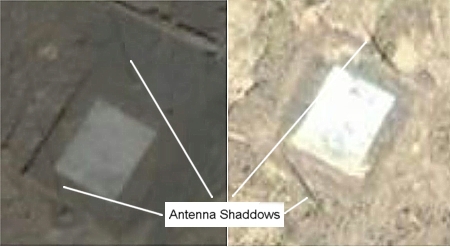 |
| Two of the pads (sites A4 and D1) have twin antennae and appear to be command and control facilities. |
.
Likewise, a string of facilities with antennae south of Da Qaidam near Xiao Qaidam might also be related to command and control operations.
Missile Activities Downtown Delingha
Traveling through Delingha a few years ago, a group of hikers described the encounter: “While trying to find accommodation we got stopped by police, one of them did some cell phoning and then offered to find a hotel for us, we were impressed! Once in the hotel there was a knock on the door- and we were confronted with ‘Alien Police’ who informed us we were in a closed city where no foreigners were allowed.”
Whether the hikers were deported because Delingha houses a nuclear missile brigade is unknown, but in the past it has been difficult to identify facilities in the city related to missile operations. A satellite photo taken on February 28, 2008, however, shows structures similar to those observed on remote launch pads outside the city in 2005 and 2006. The structures can be seen at three locations inside a 1.5 x 0.5 kilometer (0.7 x 0.3 mile) compound (see Figure 5), and appear to reveal the location of the 812 Brigade Base Headquarters for the first time.
|
Figure 5: |
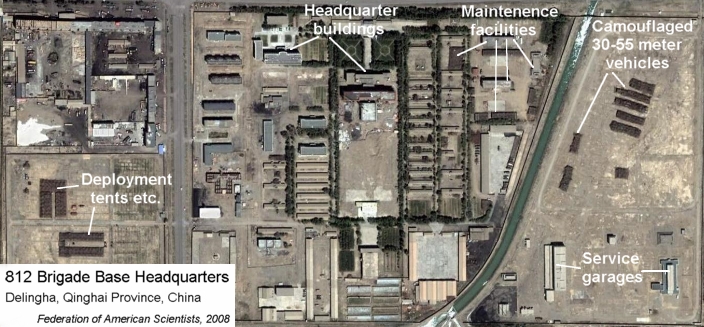 |
| Missile related facilities and equipment reveal the location of the 812 Brigade Base in downtown Delingha. Click on the image for full size. |
.
A square fenced section in the western part of the base compound is dominated by two large c-shaped structures. Closer inspection reveals that they consist of five tent-like structures, two of which are about 70 meters long and three that are 40 meters. At the end of the two larger tents is what appears to be a gate or portal. Next to the tents are two small buildings and a truck (see Figure 6).
|
Figure 6: |
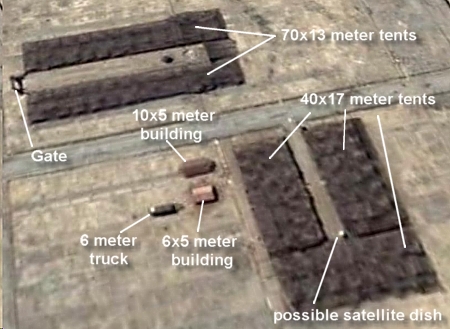 |
| Tent-like structures visible in downtown Delingha appear to be used by the missile launch brigade when it deploys to remote launch pads (see also Figure 7). |
.
These structures are hard to identify by themselves, but when comparing with earlier satellite photos from the same area they become significant because they are very similar – if not identical – to structures seen on dispersed launch pads near Delingha in 2005 and 2006. Two of those cases are reproduced in Figure 7, showing an 80-meter tent, 43 crew tents/huts, a gate, and six fuel trucks at Launch Pad B1 in 2005, as well as a DF-21 launcher with a crew tent/hut at Launch Pad B10 in 2006.
|
Figure 7: |
 |
| Tent-like structures similar to the ones detected in downtown Delingha (see Figure 6) were deployed to missile launch pads in 2005 (right) and 2006. |
.
At the eastern end of the compound is another large open facility with what appears to be camouflage nets covering unidentified vehicles. The relatively low resolution of the photos conceal many details, and it’s difficult to say whether they are vehicles or stacked equipment, how long they have been there, and whether they’ve just arrived or are being shipped out. Yet their sizes (27-56 meters) and shapes are particularly interesting because the length of the DF-21 launcher is approximately 13 meters and the DF-31 launcher is about 23 meters. At the south end of this facility are two large buildings that might be service garages for missile launchers (see Figure 8).
|
Figure 8: |
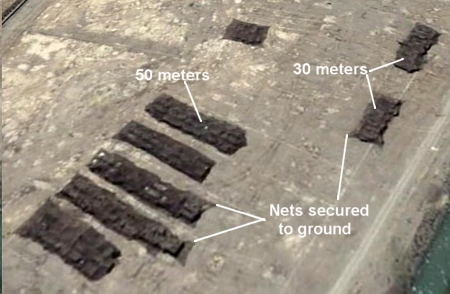 |
| Equipment similar in size to launch platforms is covered by camouflage nets. Two buildings at the south end of the facility resemble service buildings for launchers. |
.
Immediately to the west of this facility, separated by a canal, a triangle-shaped section of the main compound appears to be associated with servicing the missile units and their equipment. Clearly visible are several tents of the same basic design as those seen in the western facility and on launch pads, as well as three smaller huts and the shadow of what seems to be a gate/portal (see Future 9).
|
Figure 9: |
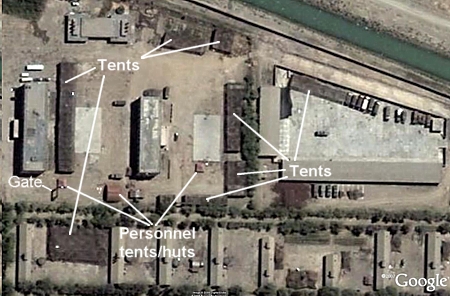 |
| Tent-like structures, red huts, and a gate/portal similar to those observed at launch sites B1 and B5 in 2005 and 2006 identify this section of the Delingha base as a possible service facility for mobile ballistic missile launchers. |
.
Implications of a Mobile Missile Force
The current head of China’s Second Artillery Corps, General Jing Zhiyuan, reportedly served as commander of the Second Artillery Base 56 in Xining, the headquarters for the Delingha missile brigade, from 1993 to 1997. As such he would have overseen the preparations for the transitioning from old liquid-fuel missiles at Delingha and Da Qaidam to solid-fuel missiles.
This change, one all the other nuclear powers made decades ago, is in full swing through the Chinese missile force. Several of the small pads detected at Delingha and Da Qaidam have been added since 2005. At that time approximately 33 of China’s deployed 91 ballistic missiles were solid-fuel, corresponding to 36 percent. Today the share is 67 out of 121 deployed missiles, or 55 percent. The share will increase in the next several years as more DF-31s and DF-31As are deployed and the DF-3As and DF-4s are retired. JL-2 missiles on Jin-class submarines will increase the percentage even more.
Similarly to the other nuclear weapon states, China is trying to reduce the vulnerability of its nuclear deterrent, and much of the debate about the new mobile missiles centers on their ability to disperse and launch quickly, making them harder for others to destroy. The small 15-meter launch pads are indeed easy to overlook compared with the larger 70-meter pads, and it is not known which of he pads will be used by launchers in a war; they might even be capable of launching from the main road. The tire tracks visible in the images and the absence of paved roads to most of the launch pads suggest the DF-31 launchers have some off-road capability.
Even so, the relatively low-resolution satellite images show that even mobile missile leave fingerprints such as tire tracks and rely on a highly visible infrastructure that includes the launch pads themselves, command and control facilities, and bases. Moreover, targeting Chinese mobile systems is far from a new and untested challenge for U.S. military planners because China and Russia have deployed – and the United States has routinely targeted – their mobile ballistic missiles since the early 1980s. Indeed, the DOD’s determination that all of China’s smallest mobile missile units – those that are hardest to detect and the most numerous – are confined to one region and nowhere else in this vast country suggests that a considerable detection (and thus targeting) capability exists today.
Mobile missiles might make it more difficult to carry out a successful first strike to destroy all of the launchers, but it doesn’t make the force invulnerable. If hidden inside a cave it is relatively simple to seal off the entrance and trap the launchers inside. Once out in the open mobile launchers can move and try to hide, but they are highly vulnerable to the blast effect of a nuclear weapon. The specific targeting and damaging requirements for U.S. nuclear forces tasked with targeting Chinese mobile missiles are not know. But the following excerpt from The U.S. Nuclear War Plan: A Time For Change (NRDC 2001, p. 54) about targeting Russian mobile SS-25 ICBMs might be a good illustrative example for targeting Chinese mobile missiles as well:
| “The 1969 Defense Intelligence Agency Physical Vulnerability Handbook—Nuclear Weapons assigns a vulnerability number of 11Q9 to road-mobile missiles with ranges of 700, 1,100, and 2,000 nautical miles or with intercontinental ranges. The damage level for this vulnerability number is defined as “transporter overturned and missile crushed.” The kill mechanism has been likened to flipping a turtle on its back. For a 100-kt weapon [the W76], the optimum height of burst to attack a target with a vulnerability number of 11Q9 is approximately 1,250 m (no local fallout would be expected), and the corresponding damage radius is 2,875 m. Thus dispersed SS-25 vehicles can be threatened over an area of approximately 26 square kilometers by a single W76 air burst. If, for example, a MAZ vehicle is traveling at 20 kilometers per hour, then one W76 explosion must occur within about 15 minutes of noting the location of the moving vehicle. While this time interval is roughly consistent with depressed-trajectory launches of SLBMs, it would require additional time to communicate the SS-25 locations to the SSBNs and retarget the missiles. The fact that Trident I or Trident II SLBMs are MIRVed, with up to eight [now estimated to be six] warheads per missile, means that a group of moving SS-25 launcher vehicles could also be pattern-attacked with W76 warheads over an area of some 200 square kilometers.” |
.
Using this example as a guide, it would require at least 24 100-kiloton W76 warheads – the load of four Trident II D5 missiles – detonating at a height of burst of 1,250 meters to ensure destruction of all the 58 launch pads identified in these satellite images, plus several more warheads to destroy the bases. Rather than aiming at each pad, warfighters would more likely try to hit the launchers before they dispersed.
The mobile nuclear cat and mouse game is on: Chinese planners are trying to hide and U.S. and Russian planners are trying to catch them.
Additional information: Chinese Nuclear Forces and U.S. Nuclear War Planning | GoogleEarth KMZ File
The FY2026 National Defense Authorization Act (NDAA) paints a picture of a Congress that is working to both protect and accelerate nuclear modernization programs while simultaneously lacking trust in the Pentagon and the Department of Energy to execute them.
While advanced Chinese language proficiency and cultural familiarity remain irreplaceable skills, they are neither necessary nor sufficient for successful open-source analysis on China’s nuclear forces.
Satellite imagery has long served as a tool for observing on-the-ground activity worldwide, and offers especially valuable insights into the operation, development, and physical features related to nuclear technology.
This report outlines a framework relying on “Cooperative Technical Means” for effective arms control verification based on remote sensing, avoiding on-site inspections but maintaining a level of transparency that allows for immediate detection of changes in nuclear posture or a significant build-up above agreed limits.